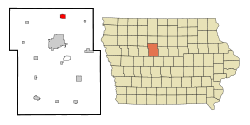Badger, Iowa
| Badger, Iowa | |
|---|---|
| City | |
 Location of Badger, Iowa | |
| Coordinates: 42°36′55″N 94°8′40″W / 42.61528°N 94.14444°WCoordinates: 42°36′55″N 94°8′40″W / 42.61528°N 94.14444°W | |
| Country |
|
| State |
|
| County | Webster |
| Area[1] | |
| • Total | 1.09 sq mi (2.82 km2) |
| • Land | 1.09 sq mi (2.82 km2) |
| • Water | 0 sq mi (0 km2) |
| Elevation | 1,152 ft (351 m) |
| Population (2010)[2] | |
| • Total | 561 |
| • Estimate (2016)[3] | 548 |
| • Density | 515/sq mi (198.7/km2) |
| Time zone | UTC-6 (Central (CST)) |
| • Summer (DST) | UTC-5 (CDT) |
| ZIP code | 50516 |
| Area code(s) | 515 |
| FIPS code | 19-04195 |
| GNIS feature ID | 0454304 |
Badger is a city in Webster County, Iowa, United States. The population was 561 at the 2010 census.
Geography
Badger is located at 42°36′55″N 94°08′40″W / 42.615303°N 94.144454°W (42.615303, -94.144454).[4]
According to the United States Census Bureau, the city has a total area of 1.09 square miles (2.82 km2), all of it land.[1]
Demographics
| Historical populations | ||
|---|---|---|
| Year | Pop. | ±% |
| 1900 | 240 | — |
| 1910 | 212 | −11.7% |
| 1920 | 244 | +15.1% |
| 1930 | 254 | +4.1% |
| 1940 | 251 | −1.2% |
| 1950 | 301 | +19.9% |
| 1960 | 340 | +13.0% |
| 1970 | 465 | +36.8% |
| 1980 | 653 | +40.4% |
| 1990 | 569 | −12.9% |
| 2000 | 610 | +7.2% |
| 2010 | 561 | −8.0% |
| 2016 | 548 | −2.3% |
| Source:"American FactFinder". United States Census Bureau.
and Iowa Data Center Source: | ||
2010 census
As of the census[2] of 2010, there were 561 people, 215 households, and 163 families residing in the city. The population density was 514.7 inhabitants per square mile (198.7/km2). There were 229 housing units at an average density of 210.1 per square mile (81.1/km2). The racial makeup of the city was 97.7% White, 0.4% African American, 0.2% Native American, 0.2% Asian, and 1.6% from two or more races. Hispanic or Latino of any race were 1.2% of the population.
There were 215 households of which 37.2% had children under the age of 18 living with them, 63.3% were married couples living together, 7.4% had a female householder with no husband present, 5.1% had a male householder with no wife present, and 24.2% were non-families. 20.9% of all households were made up of individuals and 8.4% had someone living alone who was 65 years of age or older. The average household size was 2.61 and the average family size was 3.03.
The median age in the city was 38.7 years. 26.9% of residents were under the age of 18; 8.1% were between the ages of 18 and 24; 26.4% were from 25 to 44; 26% were from 45 to 64; and 12.7% were 65 years of age or older. The gender makeup of the city was 49.4% male and 50.6% female.
2000 census
As of the census[6] of 2000, there were 610 people, 227 households, and 172 families residing in the city. The population density was 360.7 people per square mile (139.4/km2). There were 232 housing units at an average density of 137.2 per square mile (53.0/km2). The racial makeup of the city was 99.67% White, and 0.33% from two or more races. Hispanic or Latino of any race were 0.49% of the population.
There were 227 households out of which 41.4% had children under the age of 18 living with them, 64.3% were married couples living together, 8.4% had a female householder with no husband present, and 24.2% were non-families. 19.8% of all households were made up of individuals and 11.9% had someone living alone who was 65 years of age or older. The average household size was 2.69 and the average family size was 3.10.
30.0% were under the age of 18, 7.7% from 18 to 24, 27.9% from 25 to 44, 21.6% from 45 to 64, and 12.8% were 65 years of age or older. The median age was 33 years. For every 100 females, there were 100.0 males. For every 100 females age 18 and over, there were 95.9 males.
The median income for a household in the city was $41,250, and the median income for a family was $46,250. Males had a median income of $35,000 versus $21,458 for females. The per capita income for the city was $15,573. About 6.1% of families and 7.8% of the population were below the poverty line, including 11.2% of those under age 18 and 6.3% of those age 65 or over.
References
- 1 2 "US Gazetteer files 2010". United States Census Bureau. Archived from the original on 2012-01-24. Retrieved 2012-05-11.
- 1 2 "American FactFinder". United States Census Bureau. Retrieved 2012-05-11.
- ↑ "Population and Housing Unit Estimates". Retrieved June 9, 2017.
- ↑ "US Gazetteer files: 2010, 2000, and 1990". United States Census Bureau. 2011-02-12. Retrieved 2011-04-23.
- ↑ "Census of Population and Housing". Census.gov. Archived from the original on May 12, 2015. Retrieved June 4, 2015.
- ↑ "American FactFinder". United States Census Bureau. Archived from the original on 2013-09-11. Retrieved 2008-01-31.